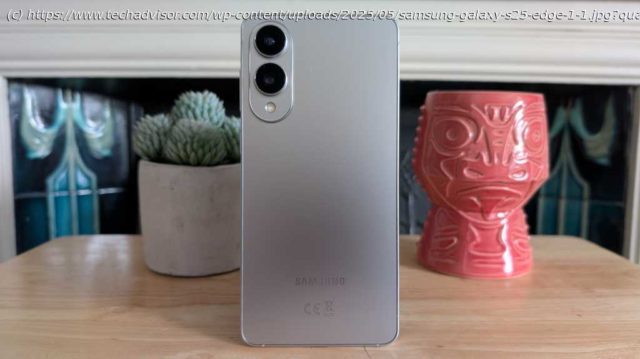After using the S25 Edge for over a week, all my design concerns have been addressed, but Samsung’s thin, light phone is far from a runaway success
Price When Reviewed
1249
Best Prices Today: Samsung Galaxy S25 Edge (256 GB)
Samsung releases dozens of phones each year, but few have generated a buzz like the Galaxy S25 Edge.
First teased at the end of the Galaxy S25 series launch in January, Samsung’s new ultra-thin flagship was the subject of near-constant leaks in the months leading up to its May launch.
So, does the S25 Edge justify the hype, or fall flat on its face? What, if anything, do you have to give up to get an incredibly thin phone? I spent over a week using the Galaxy S25 Edge to find out – here are my in-depth thoughts. Design & Build
5.8mm, 163g
Durable glass and titanium build
IP68 water and dust resistance
It feels very appropriate that form is the first thing to be discussed, as the design of the S25 Edge is the only reason to buy it over the other Galaxy S25 phones – but what a design it is.
At just 5.8mm, it’s the slimmest Galaxy S series phone to date, and one of the thinnest phones ever made. In fact, it’s barely thicker than the USB-C port. To get much slimmer, you’d have to go totally portless, but it doesn’t feel like we’re quite ready for that yet.
At 163g, the S25 Edge’s weight is less remarkable. It’s not even the lightest phone in the Galaxy S25 series – that award goes to the 162g regular Galaxy S25 – though you will get a significantly larger 6.7-inch display here.
And the benefits of this lightweight design became abundantly clear during my testing. Using the S25 Edge for upwards of 30 minutes at a time caused none of the usual hand strain, and I barely even noticed it was in my pocket at times. However, the latter speaks partly to the size of most men’s trouser pockets, and women may not be able to say the same.
Ultimately, it’s the combination of thin and light that makes the S25 Edge so impressive. I was concerned that this would make it feel flimsy, but Samsung has ensured that this isn’t the case.
The glass front is equipped with Gorilla Glass Ceramic 2, making it the first smartphone to have this. Manufacturer Corning suggests it can survive drops of up to 1m on a “surface replicating concrete”. For obvious reasons, I didn’t try this myself, but it was totally unscathed after falling onto a table and the leg of a chair.
Alongside Gorilla Glass Victus 2 on the back and a titanium frame, the S25 Edge is built to withstand more than just normal wear and tear. Just like the other S25 phones, you also get an IP68 rating, meaning it’s fully protected against dust and submersion in up to 1.5m of fresh water.
As a result, I felt fairly comfortable using the phone case-free throughout my testing. The sole issue was the lack of grip from the glass back, which meant it fell out of my pocket on a few occasions.
The only solution to this is to apply a case, which rather defeats the point of having such a slim phone. However, the official Samsung ones I’ve tried manage to keep bulk to an absolute minimum. It might be something you only use occasionally, as needed.
However, the number of people who will use the S25 Edge case-free makes the colour options all the more disappointing. It’s available in just three – Silver, Icyblue and Jetblack – while there are no fewer than seven different variants of the S25+. There’s nothing wrong with the Silver model I tried, but it is a bit boring. Screen & Speakers
6.7-inch QHD+ AMOLED
120Hz, 2600 nits of peak brightness
Stereo speakers
The Galaxy S25 Edge boasts a 6.7-inch, QHD+ (1440 x 3120) AMOLED display, complete with a dynamic 120Hz refresh rate.
If that sounds familiar, it’s because it’s identical to the Galaxy S25+. Literally. They have the exact same screen. Instead of copying and pasting what I said in my S25+ review (but feel free to read my thoughts there too), I’ll try to describe it again.
The S25 Edge’s display is excellent and undoubtedly one of its best features. It’s incredibly detailed, even if you don’t bump the resolution up from the default FHD+ (2340 x 1080).
As an OLED, you get rich, vibrant colours and deep blacks, making it perfect for movies or TV. At the same time, I love that Samsung gives you the option to swap out the default ‘Vivid’ mode for ‘Natural’ and even fine-tune the white balance or colour temperature to your liking.
The 120Hz refresh rate means scrolling and navigation feel incredibly smooth and fluid, although I would’ve liked the option to stick at 120Hz the whole time. Instead, you’ll have to choose between an automatically adjusting ‘Adaptive’ mode and a fixed 60Hz, which I’d only recommend if you’re trying to conserve battery life.
Another small thing to be aware of is that the S25 Edge doesn’t benefit from the anti-reflective coating found on the S25 Ultra, although you can buy a similar-looking screen protector from the Samsung website.
Either way, with a peak brightness of 2600 nits (I recorded an impressive 743 nits at home), visibility, even in direct sunlight, isn’t an issue at all.
Make no mistake: the S25 Edge’s display is excellent in pretty much all scenarios, even if it’s a small step down from the Ultra.
Sadly, the same can’t be said for the in-display fingerprint sensor. Just like the other S25 phones, it’s an ultrasonic version, so it should be faster and more reliable than the more popular optical ones. But in my experience, it was slow, unreliable and very sensitive to moisture. Luckily, the face unlock is secure enough to authenticate payments and log into banking apps, so I just used that instead.
Like the vast majority of phones, the S25 Edge has stereo speakers: one at the bottom, plus the earpiece. I’d describe the audio as above average, with a nice depth to the sound, but it still lacks bass and can sound tinny at high volumes. As usual, connect headphones if you’re serious about sound quality.






